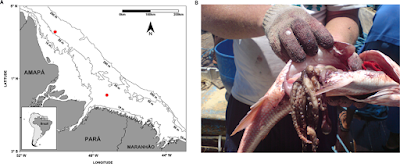Abstract
The cephalopod fauna of the southwestern Atlantic is especially poorly-known because sampling is mostly limited to commercial net-fishing operations that are relatively inefficient at obtaining cephalopods associated with complex benthic substrates. Cephalopods have been identified in the diets of many large marine species but, as few hard structures survive digestion in most cases, the identification of ingested specimens to species level is often impossible. Samples can be identified by molecular techniques like barcoding and for cephalopods, mitochondrial 16S and COI genes have proven to be useful diagnostic markers for this purpose. The Amazon River estuary and continental shelf are known to encompass a range of different substrates with recent mapping highlighting the existence of an extensive reef system, a type of habitat known to support cephalopod diversity. The present study identified samples of the cephalopod fauna of this region obtained from the stomachs of red snappers, Lutjanus purpureus, a large, commercially-important fish harvested by fisheries using traps and hook-and-line gear that are capable of sampling habitats inaccessible to nets. A total of 98 samples were identified using molecular tools, revealing the presence of three squid species and eight MOTUs within the Octopodidae, representing five major clades. These include four known genera, Macrotritopus, Octopus, Scaeurgus and Amphioctopus, and one basal group distinct from all known octopodid genera described here as Lepidoctopus joaquini Haimovici and Sales, new genus and species. Molecular analysis of large predatory fish stomach contents was found to be an incredibly effective extended sampling method for biodiversity surveys where direct sampling is very difficult.
The cephalopod fauna of the southwestern Atlantic is especially poorly-known because sampling is mostly limited to commercial net-fishing operations that are relatively inefficient at obtaining cephalopods associated with complex benthic substrates. Cephalopods have been identified in the diets of many large marine species but, as few hard structures survive digestion in most cases, the identification of ingested specimens to species level is often impossible. Samples can be identified by molecular techniques like barcoding and for cephalopods, mitochondrial 16S and COI genes have proven to be useful diagnostic markers for this purpose. The Amazon River estuary and continental shelf are known to encompass a range of different substrates with recent mapping highlighting the existence of an extensive reef system, a type of habitat known to support cephalopod diversity. The present study identified samples of the cephalopod fauna of this region obtained from the stomachs of red snappers, Lutjanus purpureus, a large, commercially-important fish harvested by fisheries using traps and hook-and-line gear that are capable of sampling habitats inaccessible to nets. A total of 98 samples were identified using molecular tools, revealing the presence of three squid species and eight MOTUs within the Octopodidae, representing five major clades. These include four known genera, Macrotritopus, Octopus, Scaeurgus and Amphioctopus, and one basal group distinct from all known octopodid genera described here as Lepidoctopus joaquini Haimovici and Sales, new genus and species. Molecular analysis of large predatory fish stomach contents was found to be an incredibly effective extended sampling method for biodiversity surveys where direct sampling is very difficult.
Family Octopodidae d’Orbigny, 1840
Subfamily Octopodinae d’Orbigny, 1840
Lepidoctopus joaquini Haimovici and Sales, gen. et sp. nov.
Diagnosis of the genera and species: small sized benthic octopod, largest examined specimen 40 mm mantle length (ML); mantle, head and base of arms covered by large rounded papillae-like dermal cushions more densely packed and larger on dorsal mantle and smaller on head and web; some papillae on dorsal mantle bear cirri branched in multiple tips; no lateral ridge observed; eyes moderate in size, slightly protruding and with single supraocular papillae with large branched cirrus, funnel half of ML; arms long, first and second typically around 4.5 times ML, third and fourth under 4.0 times ML; web typically half of ML; normal arms with up to 170 suckers, first 4 to 6 proximal suckers in single series, followed biserial to tips of arms; enlarged suckers in fourth to sixth biserial rows of males; third left arm of males hectocotylized, ~77% of the opposite third arm with 68 to 72 suckers, Short hectocotylus, ~22% of hectocotylized arm, with short conical calamus, 2% of ligula length, slender ligula with deep longitudinal groove ending in blunt tip.
....
Etymology: The genus name is a combination of lepido from scale in Greek, referring to the scaly appearance given by the large almost overlapping papillae (dermal cushions) on its skin giving it a peculiar appearance as if it is covered with scales, and octopus. The name joaquini refers to the young son of the first author of this paper (João Bráullio de Luna Sales).

João Bráullio de Luna Sales, Manuel Haimovici, Jonathan Stuart Ready, Rosália Furtado Souza, Yrlene Ferreira, Jessica de Cassia Silva Pinon, Luis Fernando Carvalho Costa, Nils Edvin Asp, Iracilda Sampaio and Horacio Schneider. 2019. Surveying Cephalopod Diversity of the Amazon Reef System using Samples from Red Snapper Stomachs and Description of A New Genus and Species of Octopus. Scientific Reports. volume 9, 5956. DOI: 10.1038/s41598-019-42464-8


